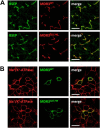A mutation within the extended X loop abolished substrate-induced ATPase activity of the human liver ATP-binding cassette (ABC) transporter MDR3
- PMID: 25533467
- PMCID: PMC4335229
- DOI: 10.1074/jbc.M114.588566
A mutation within the extended X loop abolished substrate-induced ATPase activity of the human liver ATP-binding cassette (ABC) transporter MDR3
Abstract
The human multidrug resistance protein 3 (MDR3/ABCB4) belongs to the ubiquitous family of ATP-binding cassette (ABC) transporters and is located in the canalicular membrane of hepatocytes. There it flops the phospholipids of the phosphatidylcholine (PC) family from the inner to the outer leaflet. Here, we report the characterization of wild type MDR3 and the Q1174E mutant, which was identified previously in a patient with progressive familial intrahepatic cholestasis type 3 (PFIC-3). We expressed different variants of MDR3 in the yeast Pichia pastoris, purified the proteins via tandem affinity chromatography, and determined MDR3-specific ATPase activity in the presence or absence of phospholipids. The ATPase activity of wild type MDR3 was stimulated 2-fold by liver PC or 1,2-dioleoyl-sn-glycero-3-phosphatidylethanolamine lipids. Furthermore, the cross-linking of MDR3 with a thiol-reactive fluorophore blocked ATP hydrolysis and exhibited no PC stimulation. Similarly, phosphatidylethanolamine, phosphatidylserine, and sphingomyelin lipids did not induce an increase of wild type MDR3 ATPase activity. The phosphate analogues beryllium fluoride and aluminum fluoride led to complete inhibition of ATPase activity, whereas orthovanadate inhibited exclusively the PC-stimulated ATPase activity of MDR3. The Q1174E mutation is located in the nucleotide-binding domain in direct proximity of the leucine of the ABC signature motif and extended the X loop, which is found in ABC exporters. Our data on the Q1174E mutant demonstrated basal ATPase activity, but PC lipids were incapable of stimulating ATPase activity highlighting the role of the extended X loop in the cross-talk of the nucleotide-binding domain and the transmembrane domain.
Keywords: ABC Transporter; ATPase; Lipid Transport; Liver Injury; MDR1; MDR3; Multidrug Transporter; PFIC-3; Transmission Interface; X Loop.
© 2015 by The American Society for Biochemistry and Molecular Biology, Inc.
Figures






Similar articles
-
Detergent screening and purification of the human liver ABC transporters BSEP (ABCB11) and MDR3 (ABCB4) expressed in the yeast Pichia pastoris.PLoS One. 2013 Apr 4;8(4):e60620. doi: 10.1371/journal.pone.0060620. Print 2013. PLoS One. 2013. PMID: 23593265 Free PMC article.
-
Monomeric bile acids modulate the ATPase activity of detergent-solubilized ABCB4/MDR3.J Lipid Res. 2021;62:100087. doi: 10.1016/j.jlr.2021.100087. Epub 2021 May 20. J Lipid Res. 2021. PMID: 34022183 Free PMC article.
-
ABCB4/MDR3 in health and disease - at the crossroads of biochemistry and medicine.Biol Chem. 2019 Sep 25;400(10):1245-1259. doi: 10.1515/hsz-2018-0441. Biol Chem. 2019. PMID: 30730833 Review.
-
Heterozygous MDR3 missense mutation associated with intrahepatic cholestasis of pregnancy: evidence for a defect in protein trafficking.Hum Mol Genet. 2000 May 1;9(8):1209-17. doi: 10.1093/hmg/9.8.1209. Hum Mol Genet. 2000. PMID: 10767346
-
Genetic cholestasis, causes and consequences for hepatobiliary transport.Liver Int. 2003 Oct;23(5):315-22. doi: 10.1034/j.1478-3231.2003.00856.x. Liver Int. 2003. PMID: 14708891 Review.
Cited by
-
Dissecting the Forces that Dominate Dimerization of the Nucleotide Binding Domains of ABCB1.Biophys J. 2018 Jan 23;114(2):331-342. doi: 10.1016/j.bpj.2017.11.022. Biophys J. 2018. PMID: 29401431 Free PMC article.
-
Structure of the human lipid exporter ABCB4 in a lipid environment.Nat Struct Mol Biol. 2020 Jan;27(1):62-70. doi: 10.1038/s41594-019-0354-3. Epub 2019 Dec 23. Nat Struct Mol Biol. 2020. PMID: 31873305
-
Interdomain communication in a homodimeric ABC transporter.J Biol Chem. 2024 Jul;300(7):107440. doi: 10.1016/j.jbc.2024.107440. Epub 2024 Jun 5. J Biol Chem. 2024. PMID: 38844133 Free PMC article.
-
Functional Rescue of Trafficking-Impaired ABCB4 Mutants by Chemical Chaperones.PLoS One. 2016 Feb 22;11(2):e0150098. doi: 10.1371/journal.pone.0150098. eCollection 2016. PLoS One. 2016. PMID: 26900700 Free PMC article.
-
Comparison of mechanistic transport cycle models of ABC exporters.Biochim Biophys Acta Biomembr. 2018 Apr;1860(4):818-832. doi: 10.1016/j.bbamem.2017.10.028. Epub 2017 Oct 31. Biochim Biophys Acta Biomembr. 2018. PMID: 29097275 Free PMC article. Review.
References
-
- Oude Elferink R. P., Paulusma C. C. (2007) Function and pathophysiological importance of ABCB4 (MDR3 P-glycoprotein). Pflugers Arch. 453, 601–610 - PubMed
-
- Smit J. J., Schinkel A. H., Oude Elferink R. P., Groen A. K., Wagenaar E., van Deemter L., Mol C. A., Ottenhoff R., van der Lugt N. M., van Roon M. A. (1993) Homozygous disruption of the murine mdr2 P-glycoprotein gene leads to a complete absence of phospholipid from bile and to liver disease. Cell 75, 451–462 - PubMed
-
- Smith A. J., de Vree J. M., Ottenhoff R., Oude Elferink R. P., Schinkel A. H., Borst P. (1998) Hepatocyte-specific expression of the human MDR3 P-glycoprotein gene restores the biliary phosphatidylcholine excretion absent in Mdr2(−/−) mice. Hepatology 28, 530–536 - PubMed
-
- Smith A. J., Timmermans-Hereijgers J. L., Roelofsen B., Wirtz K. W., van Blitterswijk W. J., Smit J. J., Schinkel A. H., Borst P. (1994) The human MDR3 P-glycoprotein promotes translocation of phosphatidylcholine through the plasma membrane of fibroblasts from transgenic mice. FEBS Lett. 354, 263–266 - PubMed
-
- van Helvoort A., Smith A. J., Sprong H., Fritzsche I., Schinkel A. H., Borst P., van Meer G. (1996) MDR1 P-glycoprotein is a lipid translocase of broad specificity, while MDR3 P-glycoprotein specifically translocates phosphatidylcholine. Cell 87, 507–517 - PubMed
Publication types
MeSH terms
Substances
LinkOut - more resources
Full Text Sources

